Mergers between the Milky Way and long-ago dwarf galaxies have enriched our skies with dozens of iconic globular clusters. Many are visible in small telescopes.
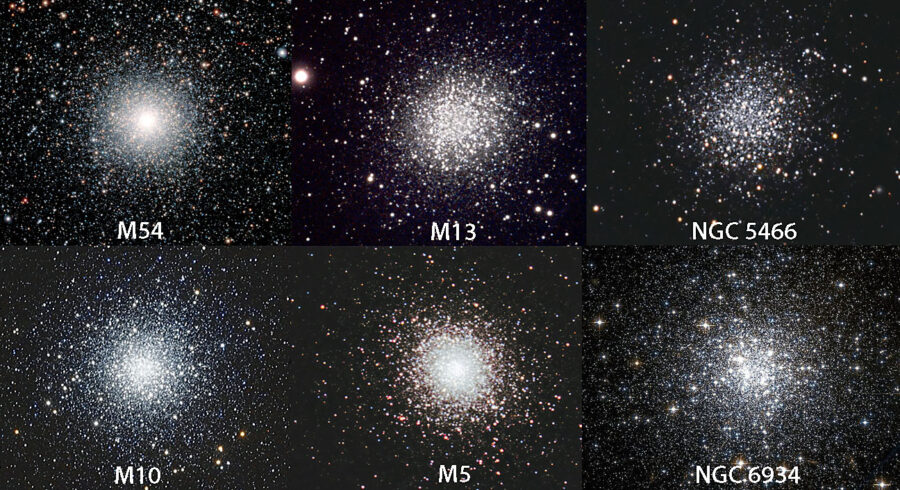
Top row: ESO / Mike Brown / Hunter Wilson; Bottom row: Manfred Höcherl / Hunter Wilson / NASA / ESA
The Milky Way is a magnificent barred spiral galaxy more than 100,000 light-years in diameter and home to several hundred billion suns. But 13.6 billion years ago — within spitting distance of the Big Bang — it coalesced from clouds of gas into a lumpy, irregular mass bearing little resemblance to the place we know today. As its gravitational prowess grew it drew in more gas and spun faster and faster. The lumps smoothed out, the galaxy flattened, and its signature spiral arms took shape.
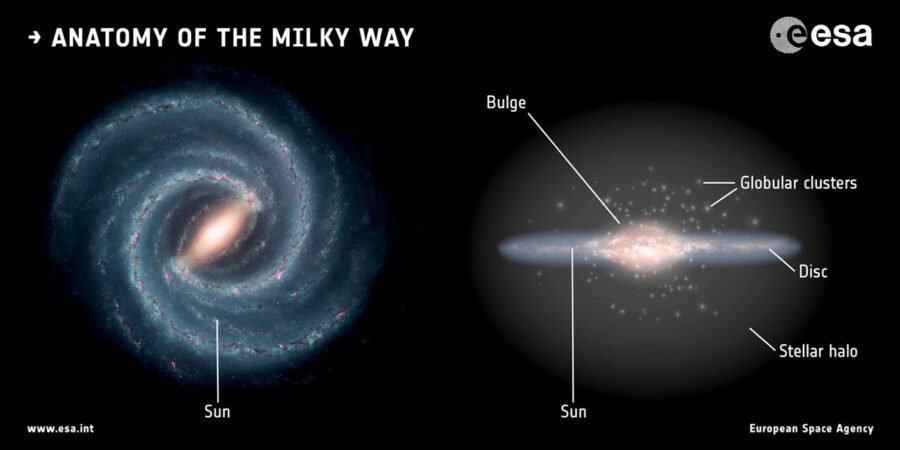
NASA/JPL-Caltech (right), ESA and ATG medialab
Gravity molded the abundant gas into the first generation of stars which in turn exploded as supernovae and enriched the cosmic medium with more complex elements that built later generations of stars including globular clusters, the galaxy's most ancient inhabitants. Tightly bound, nearly spherical agglomerations of stars, these cosmic disco balls are thought to have formed even before the Milky Way flattened into a disk, which is the reason they reside in the halo. Many of the currently known galaxy's ~160 globular clusters coalesced from massive molecular clouds 12–13 billion years ago and have persisted to this day. Having "seen it all," we might regard them as the galaxy's historians.
In the early universe collisions and mergers were more common because galaxies were packed closer together. The Milky Way grew up during this rough-and-tumble time, expanding its borders and diversifying its holdings by ingesting smaller galaxies. Big galaxies eat little galaxies even to this day, gobbling up stars and pickpocketing star clusters. In a familiar example, M81 and M82 in Ursa Major joust like two knights of old. But instead of lances they use gravity to inflict bursts of star formation and disk-warping tidal forces on each other. The battle will finally conclude when the two merge into a single entity several billion years hence.
Video: H.H. Koppelman, A. Villalobos and A. Helmi / Kapteyn Astronomical Institute / Univ. of Groningen
Merger Timelines
Diederik Kruijssen (Heidelberg University, Germany, and Harvard) and colleagues, as well as Duncan Forbes (Swinburne University, Australia), have studied the ages, dynamics, and chemical compositions of the Milky Way's globular clusters to unravel the history of our galaxy's cannibalistic ways. Their research reveals that between about 11 billion and 8 billion years ago at least five former dwarf galaxies merged with our own, "donating" approximately a billion stars and up to 76 globular clusters.
Below is a play-by-play of what went down long before any of us looked up. Because the timelines and naming schemes in the research cited above vary somewhat, for consistency's sake I've primarily referred to Forbes's data. Merger dates are approximate.
- 11 billion years ago — Koala bears sleep 18–22 hours a day so it seemed appropriate to dub the low-energy dwarf galaxy that merged with the Milky Way Koala. The one-time dwarf possessed about a billion stars and numerous globular clusters, 21 of which are now bona fide members of our own galaxy. (Koala is the same object Kruijssen and collaborators call Kraken.)
- 10 billion years ago — Sequoia not only relinquishes an unknown number of suns but also nine globular clusters including Omega Centauri, its likely nucleus.
- 9–11 billion years ago — Gaia-Enceladus, also known as the Gaia Sausage, collides with the Milky Way and contributes 28 globular clusters. Its nucleus now lives a second life as the massive globular NGC 1851 in Columba.
- 8–9 billion years ago — The Sagittarius Dwarf Elliptical Galaxy adds nine clusters including its former nucleus, M54.
- 5–8 billion years ago — A small galaxy torn into rivulets of stars named the Helmi streams parts with nine globulars.
- The final bunch called the "High energy" group and totaling 11 globulars don't have a common origin. They likely arrived singly or perhaps two at a time from the merger of small, irregular galaxies.
Except where noted in the table below, all globular clusters listed are probable members of the dwarf galaxies described in Forbes's article "Reverse Engineering the Milky Way." Messier objects are bolded. Kruijssen's group's "Kraken" article and this earlier Sky & Telescope post provide additional details.
| Koala | NGC 5946, NGC 5986, M80, NGC 6139, NGC 6144, M10, NGC 6256, M19, NGC 6287, M9, NGC 6401, M14, NGC 6453, NGC 6517, NGC 6541, NGC 6544, M70, NGC 6712, M55, FSR 1735, Ton 2 |
| Sequoia | NGC 3201, Omega Centauri, NGC 5466, NGC 6101, NGC 6535, NGC 7006, IC 4499, FSR 1758, Palomar 13 |
| Gaia-Enceladus | NGC 288, NGC 362, NGC 1261, NGC 1851, NGC 1904, NGC 2298, NGC 2808, NGC 4147, NGC 4833, NGC 5286, NGC 5897, M13, NGC 6229, NGC 6235, NGC 6284, M92, M56, M75, M2, M30, NGC 7492, IC 1257, Djorg 1, Terzan 10, ESO-SCO6, Palomar 1, Palomar 15. Tentative membership: Palomar 2 |
| Sagittarius | NGC 2419, NGC 5824, M54, Arp 2, Palomar 12, Terzan 7, Terzan 8, Whiting 1, AM 4 |
| Helmi streams | M68, M53, NGC 5053, M3, NGC 5634, M5, M72, Palomar 5, Ruprecht 106 |
| High-energy group | NGC 5694, NGC 6426, NGC 6584, NGC 6934, AM 1, Eridanus, Pyxis, Palomar 13, Palomar 4, Palomar 14, Crater |
Hello, Stranger
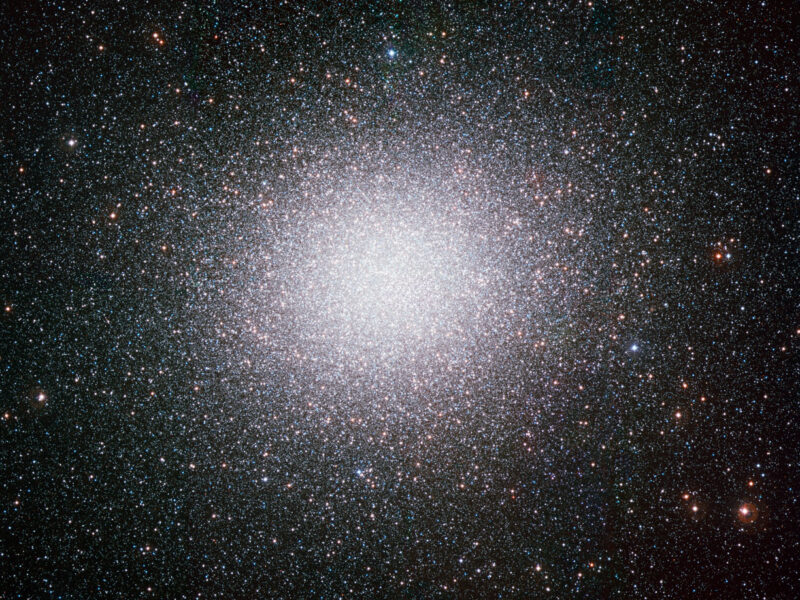
ESO
Frankly, I was blown away when I saw how many bright, familiar globular clusters were not from here. Across a lifetime of observing I had assumed that most had formed in place. It would appear that nearly half originated in unremembered galaxies! The Great Hercules Cluster M13 a vagabond? M5 snatched from a drowsy Koala?
The European Space Agency's Gaia mission has been instrumental in helping astronomers reconstruct the Milky Way's history. Launched in 2013 and expected to operate until 2025 the satellite has determined precise locations, velocities, and chemical compositions of more than two billion stars and star clusters. Every nugget of knowledge gleaned extends the trail of breadcrumbs further and further back in time.
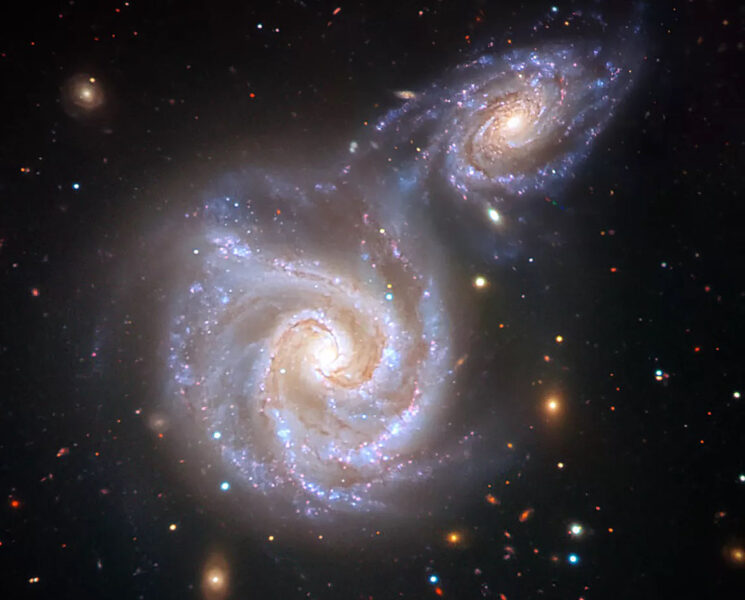
V. Belokurov (Cambridge, U.K.; and CCA, New York, U.S.) based on the image by ESO/Juan Carlos Muñoz
Earlier this month I spent two precious nights as a time-traveling galactic archaeologist. My goal was to visit 20 different globular clusters representing all five-plus mergers. I began in Coma Berenices with the Helmi stream trio of M53, NGC 5053, and M3 and finished at M54, the former nucleus of the Sagittarius Dwarf Elliptical Galaxy. At each stop I tried to appreciate how each donor galaxy enriched the halo of our own with these shimmering chandeliers of stars. M54 struck me as particularly impressive with its intensely bright, compact core surrounded by a symmetrical haze of minute, faint stars. It took little imagination to picture it dominating the center of a smaller galaxy 8 billion years ago until the heavy hand of the Milky Way plucked it like a ripe plum.
Let's Go There!
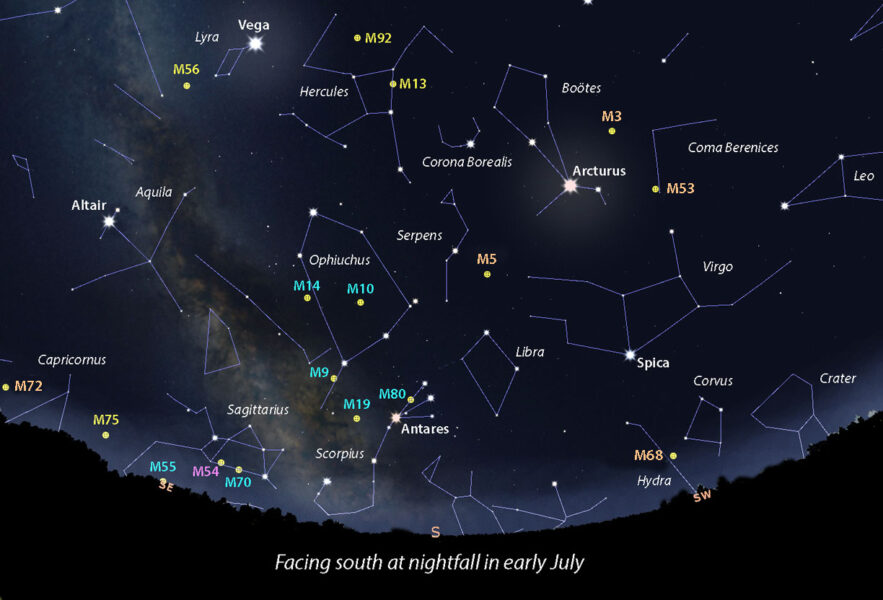
Stellarium
My 20 representatives showed great diversity in structure from tiny and faint NGC 6144 (Koala) near Antares to the splashy spangles of M10 (Koala) in Ophiuchus to the faint glitter bomb NGC 5897 (Gaia-Enceladus) in Libra. Summer nights are ideal for visiting as many of these galactic emigrants as your scope can tackle since many are well-placed at nightfall. A 6-inch scope will show at least 30 from dark skies. The map above will help you find some of the brighter Messier objects. For the others, I recommend using Sky & Telescope's Pocket Star Atlas or a free planetarium program such as Stellarium or Cartes du Ciel. The online interactive Stellarium on the Web is also excellent.
Credits: Visualization Credit: NASA; ESA; and F. Summers, STScI; Simulation Credit: NASA; ESA; G. Besla, Columbia University; and R. van der Marel, STScI
Although things have been pretty quiet in the galactic neighborhood for the past 5 billion years, the Milky Way's merging days are hardly over. Our biggest satellite galaxy — the Large Magellanic Cloud — is on a collision course and will share its riches in approximately 2.5 billion years. Whatever treasures the Milky Way has gathered over its lifetime will all become shared property in 4.5 billion years. That's when our galaxy and Andromeda are expected to merge. Impersonal as the cosmos may be there is a lesson in all of this. You can't hold onto anything forever. Letting go lets you grow.
Read more on how to observe galactic globular clusters in the June issue of Sky & Telescope magazine.
 6
6









Comments
Andrew James
June 28, 2023 at 10:54 pm
Usage of B.P. here? What's billion years compared to having starting date of the 1st January 1950? I think you'll find B.P. is far more related to carbon dating than these astronomical aeons. Moreover, 'ago' is simpler for any novice reading this article!
You must be logged in to post a comment.
Bob KingPost Author
June 29, 2023 at 12:20 am
Hi Andrew,
You really make a good point. It's funny because I originally had another description but chose B.P. for brevity. But I don't really like it, so I went with your suggestion. Thank you!
You must be logged in to post a comment.
skynr13
June 30, 2023 at 6:58 pm
Bob, It would be nice to know with these things, besides the remnants of the Galaxies in GC's, is the remnant Black Holes that might have been there centers. Do any of these GC's have especially massive BH's at there centers? If not where do you think there BH's went?
You must be logged in to post a comment.
Bob KingPost Author
June 30, 2023 at 10:59 pm
Hi Skynrt,
While many globulars may have black holes there are only a few confirmed examples. The ones I'm aware of are M15, NGC 6397 and Palomar 5. Of the three, only Palomar 5 — which arrived via the Helmi streams — is on the list of the 76 clusters cobbled by the Milky Way from past dwarf galaxies. It's possible others do but we simply haven't discovered their black holes yet. So it's probably too soon to know whether any of the clusters lost their black holes. In fact, Palomar 5 has more than 100 in its center!
You must be logged in to post a comment.
Anthony Barreiro
July 1, 2023 at 10:31 pm
Thank you Bob. This is wonderful. I regularly observe M3, M5, M13, M92, M10, and M2 with 10x42 binoculars through urban light pollution from my back yard. It is wild to think that they're from other galaxies!
You must be logged in to post a comment.
Bob KingPost Author
July 4, 2023 at 1:08 am
Hi Anthony,
Thank you! I know — my reaction was the same. Like having someone around all these years you thought you knew only to find out they've been keeping their identity secret!
You must be logged in to post a comment.
You must be logged in to post a comment.